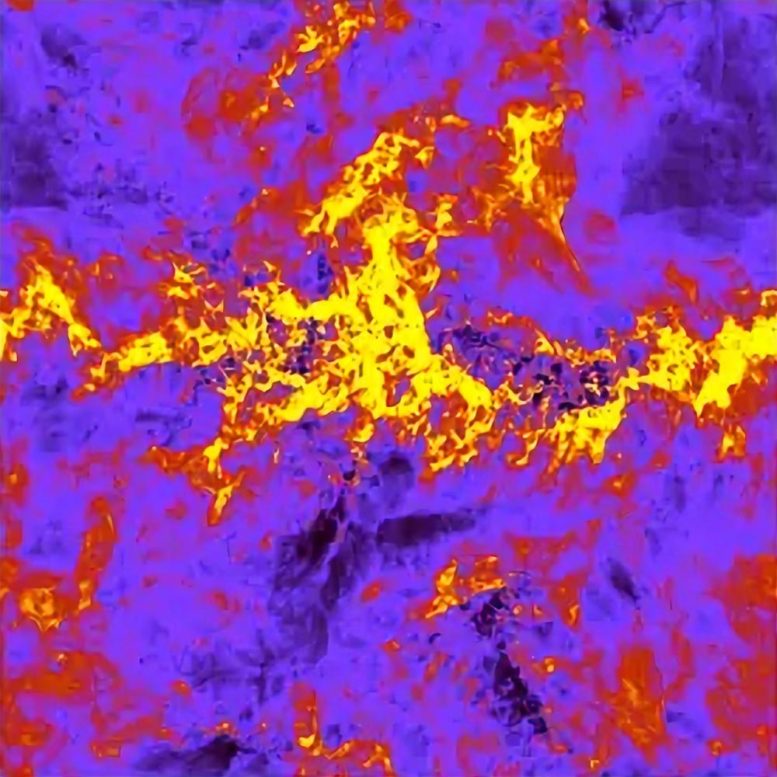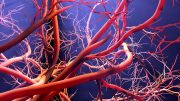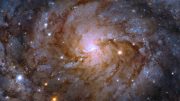
These snapshots at various times during the simulation of stimulated turbulence in hot plasma show the energy density. In the bright regions, energy and temperature are the greatest in each case. Credit: David Radice / Luciano Rezzolla (AEI)
New calculations give scientists a better understanding of turbulent processes in regimes that can be found in astrophysical phenomena.
The American Nobel Prize Laureate for Physics Richard Feynman once described turbulence as “the most important unsolved problem of classical physics,” because a description of the phenomenon from first principles does not exist. This is still regarded as one of the six most important problems in mathematics today. David Radice and Luciano Rezzolla from the Max Planck Institute for Gravitational Physics (Albert Einstein Institute / AEI) in Potsdam have now taken a major step towards solving this problem: For the first time, a new computer code has provided relativistic calculations that give scientists a better understanding of turbulent processes in regimes that can be found in astrophysical phenomena.
Turbulent flows are very common and play a major role in the dynamics of physical processes. We all come across turbulence on a daily basis, for example, every time we mix milk and coffee, or in gasoline -air mixture in combustion engines, or in the diluted hot plasma of the intergalactic medium.
Already as far back as in the 15th century, turbulent vortices were studied by Leonardo da Vinci. In the 19th century, Claude Navier and George Stokes formulated equations that described the motion of fluids and gases. The corresponding “Navier-Stokes equations” can also be used to describe turbulence. However, using simple geometrical and energetic arguments, the Russian mathematician Andrey Kolmogorov developed during the Second World War a phenomenological theory for turbulence that is still valid today.
Despite Kolmogorov’s predictions have been validated in a number of conditions, a fundamental mathematical theory of turbulence is still lacking. As a result, the “Analysis of the existence and regularity of solutions to the three-dimensional incompressible Navier-Stokes equations” is on the list of unsolved mathematical problems, for which the Clay Mathematics Institute in Cambridge/Massachusetts offered prize money to the tune of one million US dollars in the year 2000 for its solution.
“Our calculations have not solved the problem, but we are demonstrating that the previous theory has to be modified and how this should be done. This brings us one step closer to a basic theory for the description of turbulence,” says Luciano Rezzolla, head of the Numerical Relativity Theory working group at the AEI.
Rezzolla and his colleague David Radice researched turbulence in relativistic conditions of speed and energies, such as those expected near a black hole or in the early universe; in both cases, the fluid motion is close to the speed of light. The researchers used a virtual laboratory to simulate these situations taking relativistic effects into account. The corresponding nonlinear differential equations of relativistic hydrodynamics were solved on the supercomputers at AEI and the Garching-based Computing Center.
“Our studies showed that Kolmogorov’s basic predictions for relativistic phenomena must be modified, because we are observing anomalies and new effects,” says Rezzola. “Interestingly, however, the most important prediction of Kolmogorov’s theory appears to be still valid”, notes Rezzolla when referring to the so-called -5/3 Kolmogorov law, which describes how the energy of a system is transferred from large to small vortices.
With their work, the scientists also want to help formulate a comprehensive model. “We have now taken the first step,” says Luciano Rezzolla. “We intend to improve the computer codes to acquire further knowledge on the basic properties of relativistic turbulence.”
Reference: “Universality and Intermittency in Relativistic Turbulent Flows of a Hot Plasma” by David Radice and Luciano Rezzolla, 5 March 2013, The Astrophysical Journal Letters.
DOI: 10.1088/2041-8205/766/1/L10









Mathematics is the language in which humans write the universe. Mathematics does not tell humans that elementary particles must be spherical, but can be unipolar. This suggests that elementary particles may be rotating two-dimensional matter. Topological vortex is unipolar. Left rotation and right rotation are the two sides of the same topological vortex.
The prediction that Majorana fermion is its own antiparticle can be generated in the topological vortex field.